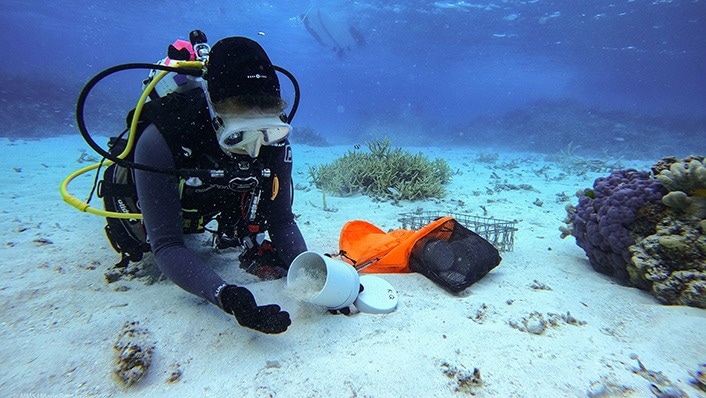The Great Barrier Reef mass coral bleaching of 2016 has revealed a complex picture of both loss and growth within the microalgal communities of corals, according to a new study led by a team from the Australian Institute of Marine Science (AIMS).
 A scientist collects environmental elements containing symbionts for later analysis. Image Credit: Marie Roman
A scientist collects environmental elements containing symbionts for later analysis. Image Credit: Marie Roman
As scientists compared the impacts of accumulated heat stress on more than 1600 coral microalgal communities that exist in a symbiotic relationship with corals before and after the 2016 event, they discovered that the environment’s diversity significantly increased.
Also, they discovered that one of the three coral species under study had an increase in the richness of more heat-resistant microalgal types.
Several microbes, including a diverse community of photosynthetic microalgae that provide corals energy, coexist with them in symbiotic, mutually beneficial ways. This association breaks down in very warm conditions, resulting in the coral animal losing its algal symbionts and turning white.
This process, called coral bleaching, can cause illness and death. It is commonly acknowledged that one of the biggest threats to corals globally is mass coral bleaching.
The study, led by Dr. Kate Quigley of AIMS (currently at the Minderoo Foundation), improves the knowledge of the species-specific ability of corals to switch or shuffle algal symbionts, which can assist in understanding how they react to rising temperatures and support efforts to manage corals in the face of climate change.
Dr. Patrick Laffy, a study co-author, stressed the need to comprehend how certain corals might alter the composition of their symbionts during bleaching events.
If you are trying to understand the resilience and dynamics of the reef under a warming climate and formulate management interventions, it is vital to understand the behavior of algal symbionts.
Dr. Patrick Laffy, Study Co-Author and Research Scientist, Genomic Bioinformatics, Australian Institute of Marine Science
Dr. Laffy added, “We found the heat-tolerant microalgae Durusdinium increased in abundance in the coral species Acropora millepora after bleaching, but this trend was not observed in the two other Acropora species. After bleaching, we also discovered the overall diversity of algal symbionts in some of the coral species had reduced. This new balance can have mixed consequences for how coral species grow and survive.”
He further stated, “In addition, we detected a more diverse pool of algal symbionts in the environment after bleaching. These are available for uptake by the young of many coral species who start off life without algal symbionts and acquire them from this pool. Coral-symbiont partnerships are a key driver of bleaching susceptibility, so understanding how the relationship can adapt is essential to predicting reef and species level vulnerability and possibly guiding interventions.”
Dr. Laffy asserts that advances in molecular and sampling technologies offer new opportunities to advance understanding of how coral symbioses respond to environmental changes presently visible on coral reefs and predict them in the future.
Researchers from James Cook University and AIMS collaborated on the work, which was supported by the Tropical Water Quality Hub of the National Environmental Science Program. The study was published in the journal Science Advances.
Journal Reference:
Quigley, K. M., et al. (2023) Symbioses are restructured by repeated mass coral bleaching. Science Advances. doi:10.1126/sciadv.abq8349.